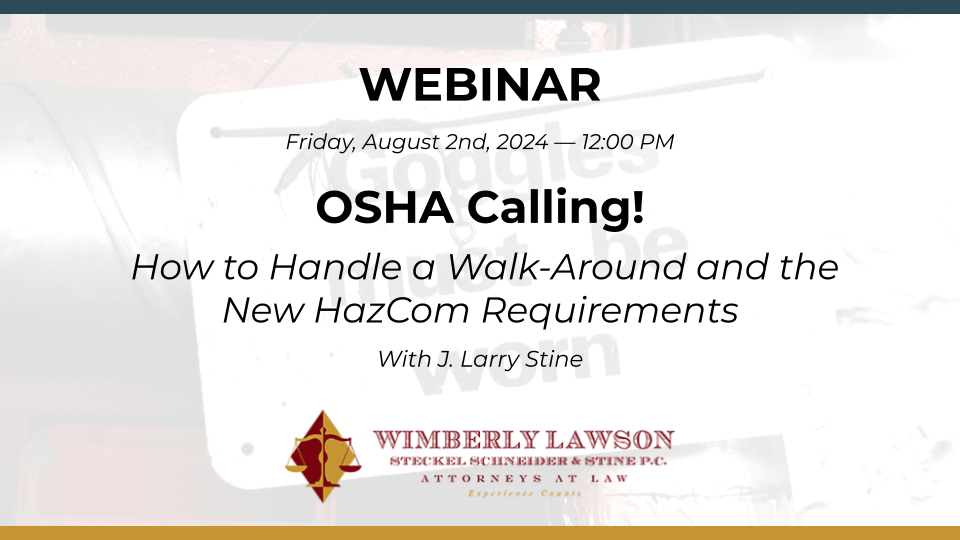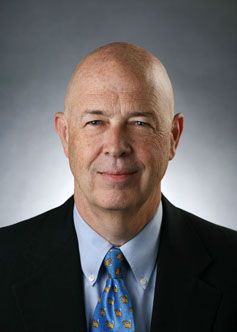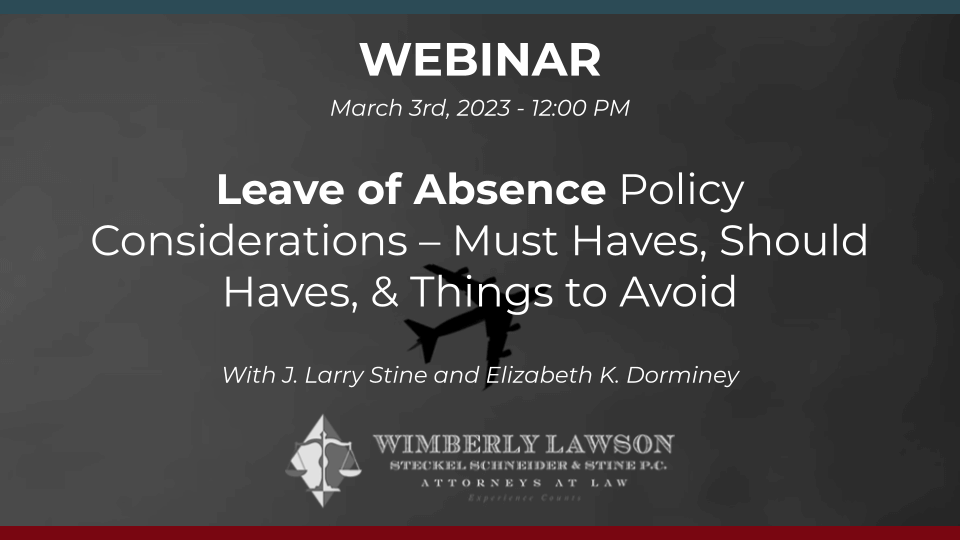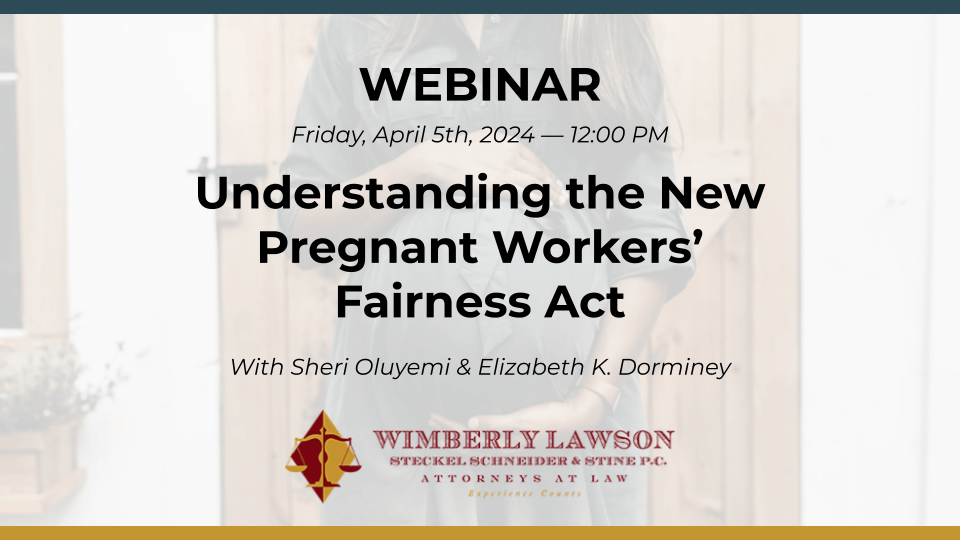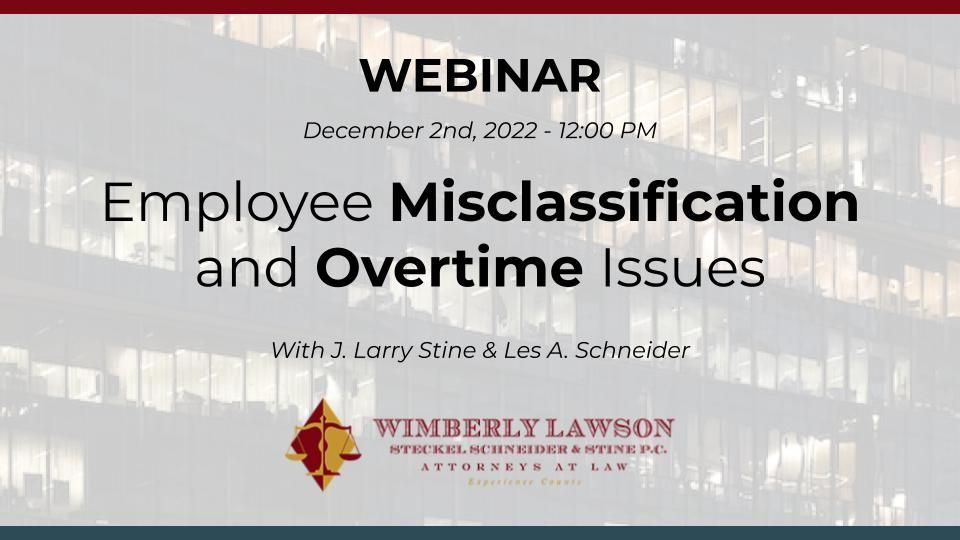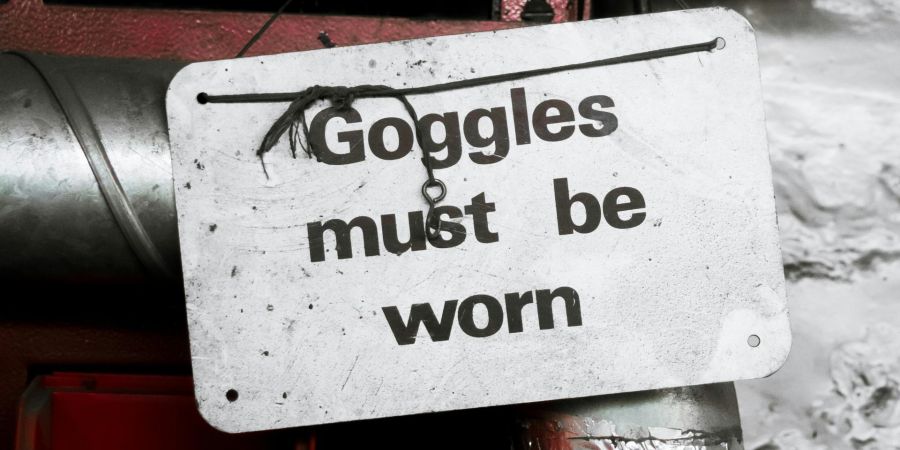
OSHA Calling! How to Handle a Walk-Around and the New HazCom Requirements
Strategy in Dealing with the OSHA Walk-Around Issues and New HazCom Requirements.
Join us for this seminar to learn about your rights and responsibilities when OSHA inspectors come knocking.
Here’s a teaser: you don’t have to accede to every demand, and shouldn’t expect any concessions if you do. Presenter Larry Stine also covers the new HazCom requirements that took effect on July 24, 2024.
Watch This Webinar
Webinar Transcript
J. Larry Stine (00:00):
Welcome to our monthly webinar. I'm Larry Stine. I'm the senior principal at Wembley Lawson, Steckel Schneider and Stine Say that fast. And I specialize in OSHA law. So today we're gonna be talking about a couple of things in osha, the walk around rule, and the new has come rules. So it's gonna be a little more technical than normal. I hope I don't make you all turn off the webinar right away. I'm looking forward to presenting this to you. I've got a, a PowerPoint. I'm gonna be on the screen sharing with you as we go through both the new OSHA walk around rule, how to handle it, and some practical considerations and some brief discussion on the new has umbrella and how it impacts you. So we're with that. I'm gonna show you the if I can find it. I'm gonna show you the PowerPoint and we'll get started.
J. Larry Stine (01:00):
So the first topic we're going to to cover is how to handle a walk around and, and the other one will be the has come. So basically here is the, it's a new regulation that became effective this year and what they did in this walk around regulation, as you can see, the 29 CFR 1903 0.8 C is what they have done is try to make it clearer in their regulations that a third, a, an employee representative does not have to be an employee of the employer. There's a couple of things we want to point out in this because, we'll, I'm gonna highlight these as we go through it. The, the first one is that it is, they're represented authorized by employees. So the un the thing you've got to understand here, the important thing is OSHA doesn't get to come in and say, Hey, I'm bringing in the union.
J. Larry Stine (02:13):
I know you're a non-union plant, but hey, we're bringing in the union guy because he's gonna represent the employees. We made that decision. That's not the power they give 'em. The power that OSHA's given is when the employees provide a representative, he is got the power to decide whether good cause has been shown, why it's reasonably necessary. So that it's, it is important to understand a couple of things about this regulation. This regulation is in this section that governs how OSHA compliance officers handle the investigation. It is not in a section that governs employers actions. And why is that important? Well, it's important because you cannot get cited for violation of 29 CFR 1903 0.8. You cannot be cited and it cannot be find, and OSHA acknowledges that. Now, I, I want you to understand that this kind of comes from a couple of sources where the information comes from.
J. Larry Stine (03:27):
So there's a couple of things that you need to look at if you really wanna understand what the new OSHA walkaround rules are there. First thing is OSHA has issued some interim guidance for Walker walk around represented designation process on May 10 24. They, this is the interim because they plan to put it in the field operation manual. It's a helpful document to determine how OSHA's going to go about doing it. Also, they, they have some FAQs on their webpage where you can see I put the site to it for that. Then there's the Federal Register where they issued it, and they have what we call the preamble. And if you haven't ever gone through the Federal Register and looked at OSHA rules, OSHA talks and gives a lot of information concerning its understanding of the rule, how it's going to enforce the rule, why they did what they did, and the preamble to the rule.
J. Larry Stine (04:32):
And it can be a wealth of information when you're looking at something like this. The final thing is they're responding to a decision out of the Northern District of Texas, the National Federation of Independent Businesses versus Daughter. And in that case, OSHA tried to bring in somebody and they were not allowed because they were not an employee representative. However, what OSHA hung its hat on is the court did say the ACT merely provides the employee representatives must be authorized by the employee, not that the representative must also be an employee of the employer. So this is the thing that Hema hat on, but the thing that you've gotta look at is the act which we'll show you in just a second does not authorize OSHA to pick a representative. It allows the employee to do, and here's the statutory provisions, it's 29 USC 6 57 E and you, you see a, it says A representative authorized by his employees shall be given an opportunity to accompany.
J. Larry Stine (05:46):
So it is critical to understand how they responded to that decision and how the statute works, and then how the rate works. The OIA has to be able to show that the person that's coming is a represent somebody that was authorized by the employees. So I, the Federal Register preamble, the first thing I think is most important, and they actually put this, it says, first, under this rule, and pursuant to the OSHA Act, any third party employee representative must be authorized by the employees. And here's an important thing, employees do not have to designate third party representatives if they don't want to. So most of the time when OSHA shows up into a non-union facility, the employees just don't do anything and OSHA does. There's not an employee representative going through the walk around. OSHA's instructions to the compliance officers when that happens is interview some of the employees to talk to them, but they do that routinely anyway.
J. Larry Stine (06:55):
So they routinely ask employees about what's going on. Another important thing that's in the preamble to the Federal Register is it says it will not disturb our rights under the Fourth Amendment, including the right to withhold or limit scope of the consent. And here's the thing I was talking about. Employers will not be subject to a citation and penalty for objecting to a particular third party representative. It, so what happens is, just to remind you, is under the fourth Amendment, we have a right not to be allow the government in without a warrant. And OSHA really can only come in to your facility under two circumstances and only two circumstances. You give them consent or they bring a warrant. Warrants are paying the butt for OSHA to do, there's a lot of paperwork. They don't really want to do it. So they will work with you in consent.
J. Larry Stine (07:59):
The other important thing to understand about consent is it's not, it's not like a light switch where it's off and on. It's more like a rea stat where you can turn the lights up or down. You can give your consent to things, some things and not give your consent to other things. Normally when we're doing it is, is when the compliance officers come in and they want, they bring in a complaint investigation, we will give consent to go into the area of the plant that is affected by the complaint and no other areas. They don't have the consent to go anywhere else other than the plant other than that limited area. And OSHA's compliance officers then have to make a decision when we limit consent, are we going to live up with this consent or do we not, can't live with it? And we do, we need to go get a warrant.
J. Larry Stine (08:59):
Now the employees set, select the representatives, however, the OSHA compliance officers determine if could cause have been shown that this individual is reasonably necessary to the inspection. So what it means is that the OSHA compliance officer can still say, no, this guy's not gonna help me. He is not gonna do anything that really helped me. So no, I'm not letting them come on. So the employees can select their representatives, but the OSHA compliance officer basically has vetoed power over that individual accompanying him. If he doesn't think they're reasonably necessary to the inspection, if they're interfering. And actually, if, you know, the employee rep gets outta hand and gets filed and starts doing things, the compliance officer can determine that they're not helpful and then direct them not to proceed with the, with the walk around. Now, in addition to the preamble, one of the important things to look at on this particular issue is the OSHA's interim guidance.
J. Larry Stine (10:13):
And it gives a, some interesting information. So what they did in the employer guidance is they set up a hierarchy of choice. So basically what happens if a compliance officer comes in and there's a, basically a union on site, the highest ranking official or union employee on site will designate who participates in the walk around. And if the union gets in a fight about who's going to do what, and there's, they know they're having an argument about it, the compliance officer under their root rule has given the authority to resolve all the disputes about who, which one is the unauthorized by the employer and the employees. So typically, if you're in a union plan, the union picks its representative and this OSHA walk around rule really has no change to how you're handling the next thing in the priority. And this is something that you need to seriously consider if you have one, if you have a safety committee they can designate the employee walk around representative for OSHA purposes.
J. Larry Stine (11:42):
So what this means is, if you kind of look at the hierarchy, this is the number two choice. They come into a non-union plant and you have a safety committee. The safety committee is the authorized employee representative to designate who does the walk around. So one of the things I want you to seriously consider about doing this is if you do have a safety committee, you need to get together with the employee representatives of the safety committee and say, okay, we need to figure out what's going to happen when OSHA shows up. By the way, it's a good idea to always have a plan in place. I suggest you have it in writing so people can look at it as to what OSHA's going, what you're going to do in OSHA shows up. And I've told people before, you're going to have a policy.
J. Larry Stine (12:35):
The only question is, is OSHA in your lobby and you're desperately trying to figure out what your policy is while they're sitting out in the lobby and you're under excruciating time pressures, are you going to have it done and thought about it ahead of time so that when OSHA compliance officers shows up, you pull out the policy and you say, this is how we're going to do it. And you need to have who's, how are you gonna handle 'em? Who you're going to call, what telephone numbers you're going to have, which employees you're going to call, or who's going to handle it? You really need to make those decisions ahead of time so that you've thought it out, you've figured out who you're gonna do. You've looked at your consent programs, you know how you're gonna handle consent. You're gonna, you're going to have planned it carefully.
J. Larry Stine (13:29):
And one of the new things, because of this interim guidance and their new walkarounds, if you have a safety committee, one of the things that you need to do is have the safety committee decide how they're going to handle it and how they're going to do the around representatives. And it gives you an opportunity as an employer to have somebody who's more favorable on the walk around than somebody just selected. Or they can make the decision that they're not gonna do it. And you can tell 'em that they have made the decision not to do it. The reason you wanna do that is that Bosha has come in and they're bringing in some one employee who's, you know, been brought in as a union organizer and he says, Hey, I want the union guy to come in as the rep. He's not the person who's authorized the safety committee is now there are third party representatives.
J. Larry Stine (14:37):
The interesting thing is when you read the federal Register, when you read the guidance, when you read the statute, when you read the regulation, there's big a hole. It says, employees may designate a third party to be their authorized representative, but there's zero discussion how this happens. I mean, you know, if you got a union how it works, that's nothing new. That's old. We now know based on the interim guidance, if you have a safety committee, you could go ahead and set it up. But if you don't have those, how, how does this, how is it that this person, how employees designate a third party representative? And is it one employee? Is it two employees? There are two employees do one and another one does another. But there's absolutely no discussion about how the employees may designate a third party to be their authorized agent.
J. Larry Stine (15:46):
Now it says the kosho has the ability to determine, determines could cause to assist. And when you look at it, you'll see one of 'em that they use as a translator. They're coming in with a third party translator because they don't wanna rely on us. You know, that's, that's something you might not have a problem with. They may be doing an ergonomics investigation based upon a complaint or a selection and then bringing it outside. Gons, you gotta make a decision what you want. We do know that if they come in and you're a non-union plan and they're bringing a union representative, you don't really think that's a good cause. And it's unclear how they selected that person. So if the employer objects the interim guidance says they will treat that as a refusal of entry, it then says that they're supposed to go back to the office, treat it as a refusal, go to the area director who will talk with the regional solicitor, and they'll make a decision whether to go get a warrant.
J. Larry Stine (17:05):
Now, one of the things that we want to do is we don't want to make that easy for them. So if they're bringing in a union rep, I, we could throw out the compliance officer and the union rep as a third party saying, we're not giving you consent. But that makes it easy for OSHA to make the decision to go get the warrant because we're leaving OSHA out and they gotta get their job done. So one of the things that I'm suggesting you do is if they come in with a 30 priority representative that you find inappropriate and that you have objections to, is that you make it clear that the co show has the consent to conduct the inspection, but without the third party. Now what's gonna happen is OSHA's gotta decide whether they want to go back to the court and get a warrant, not to get OSHA in, but to get this employee designated third party.
J. Larry Stine (18:18):
And we don't even know how they get designated half times and go to a federal judge and ask that they get a warrant to allow a non-governmental party to, to go in. It makes it a difficult decision. They can get the inspection done without this person and they gotta make a decision whether they want to do that. They probably will in some circumstances just because the they wanna make this point. They wanna make it from some poor guy that makes the decision to not let 'em in. But I'm telling you, if you were careful and only object to the third party, it's gonna be a much more difficult case for the the Department of Labor decide to go get the warrant. So if you're in that situation, you may wanna seriously consider a limited consent to the compliance officer, but not to a third party representative.
J. Larry Stine (19:16):
So let's talk about the practical considerations of what the walk around is. How's it gonna impact you? Well, if you have a union, nothing changes, the union picks the representative. And unfortunately that can include the national safety employee. I have been on inspections in which the union designates their safety representative coming in from the national union. But the, but the union employees, the union reps at the facility have to select them. But they can do it if you have a safety committee work with the employee members to decide who will be the employee representative. You can decide not to have an employee representative. But I think it's more powerful if they show up with somebody going your priority and your interim guidance. The safety committee, they've selected this person. We're not letting that per that person. We don't know who selected them and therefore we don't think that's appropriate and we don't think the employees authorized that person to do it.
J. Larry Stine (20:34):
Now the compliance officer is confronted with a safety committee. So if you think about it, typically the employee representatives on the safety committee are some of your better employees are really concerned about it and who want to work with the company and would be people you would not necessarily mind on there. Now there can be some, that's one reason you wanna work with them, employee members to select the person who you thinks the best suited. And because you don't know which shift they're going to come in, you might want to consider having one for first, second, and third. If you're a 24 hour operation, you know, if you're a one day shift, it's easy. But if you're multiple shifts during the day, you might want to consider having somebody who's working on that shift when they show up. I haven't talked about this before, but the, the regulations and the instructions make it clear that these non-employee representatives cannot go into areas be trade secrets.
J. Larry Stine (21:45):
So this can be an issue that you can control. You can basically say to them, I've got these areas we consider trade secrets and we're not allowing someone who's not our employee into the area and we're precluding them. The way it reads in the interim guidance is the compliance officer, since they have no idea what a trade secret is or not really aren't given much discretion, you tell 'em not these areas that non-employee rep cannot go into those areas. So if you've got areas with trade secrets and that's where the complaint is, then you've got another tool in your toolbox to keep that union organized out of that area. By saying trade secrets, you can't go and that really doesn't give the compliance officers much ground. Another thing that we want you to think of the practical consideration is basically how bad is the non-employee representative?
J. Larry Stine (22:51):
It is not necessarily gonna be so bad that you wanna fight the issue. Like I said before, if it's a translator, you know, you can understand they don't want to depend on your translator, they want to use theirs. I probably, if I was handling the inspection, would not object to having a translator go along 'cause it's, it seems practical and I don't think it has a major impact on as a professional agonist man, that's a little closer call maybe, maybe not. Do understand when you have something like an ergonomists, if you object to 'em and they decide not to do it and it goes into litigation, they can take the same professional agonist and litigation, designate him as the expert, file a motion to go back into the plant and all of a sudden your professional expert or God is for OSHA's back in the plant anyway.
J. Larry Stine (23:55):
Obviously, if it is a union organizer, I don't know anybody that's going to let 'em come in. I think everybody will object. And then finally what I say is, if that happens and you don't want to let them in, then you're going to give consent to the co-ho to do the inspection, but not to the non-employee representative to make it harder for them to make a decision not to go around. Now I'm gonna stop for a second on the presentation. That's the PowerPoint aspects of the of the OSHA walk around. I wanted to take a moment that if anybody has a question about walk arounds, what to do when the they show up with a third party representative, I thought now would be a good time to do it before I transition into the new hasco rule. So if anybody's got any questions, you can send it to me through chat q and a and I will look at it. So give you a moment to think about it and at the end of the discussion and after my presentation, if you have questions concerning this, I'll be glad to address 'em at that time. So anybody have any questions they wanna ask you? Okay, apparently not. So now we're going to switch over to the new has comm regulations.
J. Larry Stine (25:44):
Alright, the new has comm rule became effective July 19th, 2024. Now before any year I'll have a heart attack going, oh my god, the has come rules they changed and it's effective July 19th. I haven't done anything. That's okay. It's just the date which they became effective. However, they do have compliance date requirements and we're going to go over that first. So really the first time you have got to worry about anything is in a year and a half. So not even in 2025, I think it'll be 20, 26, 18 months after this publication. The you have to use the updated labels and stss that are coming from the chemical manufacturer, importers or distributors. A vast majority just as a preview of what these new has time rules really impact the labels, the STSS requirements and transportation and the not any real rules outside of that. But what it does to the employers, it means up getting new s ds that I'm getting new labels and I've got to look at my HACOM program and do new training.
J. Larry Stine (27:14):
So 18 months, year and a half from July the 19th. So probably around DEC January of 2020 sixth, the next deadline for you is two years. So by July 19th, 2026, you have to make any changes in a has comp program, which you're gonna be very modest by the way, and you've got to do some training as for your employees about workplace labels. So that's two years from now, three years from now, you will have to make certain that you're using all the updated labels in S SPSS for mixtures and then 42 months, three and a half years anything related to the change that was made, 36 month 36, you have to go back and make a change in your training and has comp programs, which I don't think is gonna be very necessary. And from July 19 until the completion dates above, you can either use the old standard, you could switch to the new standard or you can use both the why anybody would want to use both at the same time is beyond me. But they, that's, that's what they say you can do. So what in the world have they done with the has come rules? Well, the first thing is they've done changes to definitions. So they've provided new definitions, provoked shipment, combustible dust, hazardous chemicals, gas, immediate outer package, liquid physical hazards, physicians release per shipment in solids.
J. Larry Stine (29:15):
And when you read the definitions, they're, I don't see anything that's terribly controversial about them. They just decided that because the, what they were going to do, they needed to the transportation into the SDSs, they needed to provide some new definitions. Now they changed the hazard classification and basically they did two things. They changed, they had changed in the chemicals physical form. And then the thing that seems to be the most controversial is they're requiring the manu, the people who are designing and putting the SDSs together to have to put react to chemical reactions that products were associated with known are reasonably anticipated use or applications. Now what the manufacturers were saying is how in the world do we know what my downstream people are doing with what we're giving them? And we would not necessarily know. OSHA's response is you don't have to figure out what the off use of it, but with the normal uses that you're, you're normally rejecting these things to be, you now have to have in your SDSs anticipations the hazards to come from those known or reasonably anticipated uses or applications. So one of the big impacts of this regulation is on the SDSs. So that now they have to redo the SDSs. That's the reason it's got this transition period with new definitions, new changes in the hazard classification in these two aspects of it. And now they got to modify the SDSs. So you'll start getting new SDSs close to those transition period times.
J. Larry Stine (31:16):
Now they also made changes in the transportation rules. One of the things they were trying to do was unify the labels between transportation and the end users. But so you see that is that basically what happens is DOT has been using the osha has gone to use the same pictograms specified by, so now they're beginning to put those together, but that's what they're trying to do is to unify the PIC pictograms and the label for bulk shipments can be on the immediate container or transmitted with the shipping papers, the bill of laing. So there's now new rule for how you handle bulk shipment. And then on the other hand, there's a rule concerning new small containers. They make new changes for small and I mean small containers. They put in things that they, because they're so small, they have to put modified labels, but they've added that for the transportation folks and the people shipping it now have to put in new small container labeling groups. As you remember, there's these lovely pictograms those pictograms are being changed very minor. They won't impact upon you very much.
J. Larry Stine (32:52):
Okay, now trade secrets. Now I'm, what they did in the trade secrets is very complicated and I'm not a chemist and unless some of y'all are chemists, I don't think it is gonna impact. But they put what they call concentration rings on how they could do trade secrets for the documents they're doing in the SDSs. So for our point of view as employers, it really just gonna be, there's a change in the SDS is in the trade secret section that when we receive the SDSs we'll be able to do that. So what is it that employers are going to have to do? Well, one of the things is it's gonna update your workplace labeling under paragraph F six, but your vendors are the ones that are gonna be making these changes. So you'll simply need to replace the old SDSs or the new SDSs that come in. And if there's new labeling requirements, the pictogram requirements, the manufacturer will have to notify you of it and you will have to make those changes on the pictograms that you've had.
J. Larry Stine (34:11):
It says in the regulations, you will have to update your written program under the 1200 B one. The weird thing is, is when I've read this stuff and reviewed it, it looks like the main problem was when OSHA did the last time on the OSHA regulations, they were talking about the retention requirements and they cited the wrong go wrong standard and they realized they did it and they've adjusted. However, in the programs that I have written and the things that I have seen, employers just basically did not follow that mistake. And the standard programs have referred to 29 CFR 19 10, 10 20, which is the standard that governs how long you keep chemical rules, how long you keep testing those aspects that are impacted by the <INAUDIBLE> standards. So the the trades, the written program looks like it should be pretty modest. You might wanna look at your program and see if you had it citing 19 10, 1 20, which was the mistake they made and correct it to put 10 20.
J. Larry Stine (35:27):
But believe it or not, that about all you have to do. Now, the problem really for employers is this last one because you're supposed to to explain how the stss work and how the pictograms work. And now you're getting new changes in the STSS that you've been using and they want you to provide additional training for newly identified hazards because the SDSs are now having to look at the downstream reactions. They may be placing new hazards into your chemicals that you're using. Typically what we advise people in their training is you do not train on chemicals, you train on hazards because if you look at the 19 10, 1200 standards for training, what it really says, and there's a reason for this, is that you don't train your employees on chemicals. The reason was when they originally proposed this regulation of, you know, a very long time ago, they originally were going to have people do training and the chemical companies came back and said, we sometimes have 10,000 chemicals that were working on. It'll take us a year to train our employees on going on each MSDS for each chemical and that doesn't do you any good. And the response was, well you do not have to train on specific chemicals, you have to train on hazards.
J. Larry Stine (37:15):
Problem is that o OSHA says that they were still, remember they wanted training on chemicals and they really kinda want that even though you train on all the hazards listed in regulations. And what you you'll see is you will get OSHA citations for has o for not training on a particular chemical. We have taken that issue up to the review commission. The review commission has affirmed that the training under the HAS o standards is for the identified hazards. And so if you trained them on all the hazards listed in the HACOM standards to start with, you don't have to keep retraining when new chemicals come in because you don't have to do retraining on new chemicals. You have to do training on new hazards. But in an abundance of caution, I suggest that you have a HACOM training on these new regulations, the minor changes that they're going to have and if there's any changes in your major chemicals you're working with, you would make those changes.
J. Larry Stine (38:30):
But be aware that that osha, even though their own regulation says hazards oftentimes ignores it and tries to cite for chemicals, there's just really no way that some employers with a number of chemicals in their STS book can really train 'em on it. And honestly it, if you did the training on the employees on the chemicals and made 'em go through it, it's like going in one ear and coming out the ear, other ear because it doesn't matter to them because they really don't see how it impacts how they work and how they do it. This, the hazards is important. So that's the new has con rules. The impact upon the employers honestly is modest this time. The impact upon the chemical manufacturers, the people who have to put the sds that together and the labeling is substantially are basically making them re-look at all the SDSs that they've issued.
J. Larry Stine (39:31):
Transportation has some impact with labeling on the bulk storage and on small containers they didn't have before. If you do ships and chemicals, you have to look at those. So that is the discussion based upon what the new has gone rules have on the impact they have on, they have covered what I think is the important points. So are there any questions anybody has about the has com standard, the walk around, any peripheral issues like the Fourth Amendment and consent that has come to you during this presentation? I'd be glad to address it at that time. Well, I wanna thank y'all for participating. I hope you found this last 40 minutes informative and useful and if they have any questions that come up after the fact, 'cause I have found myself when I walk out of this seminar having more questions that I, that I wish I had asked that when I was in the seminar and it took me, you know, 15, 20 minutes or a day to come up with a question.
J. Larry Stine (40:36):
I, I want to encourage you guys to send me an email. I have no problems if you send me an email at js@wimlog.com. I'll be glad to answer those questions at a later date. It would not, I'm not going to charge you for answering a question you wanted to answer in the webinar but didn't think of at the time. So if you have any questions either now or if you're looking at this seminar on our webpage where we keep all the webinars recorded so you can go back and review them if you need to or some you haven't seen, feel free to send us emails. We'll be glad to answer them. We'll conclude this webinar and thank you for participating and I hope you have a wonderful weekend. Bye guys.
